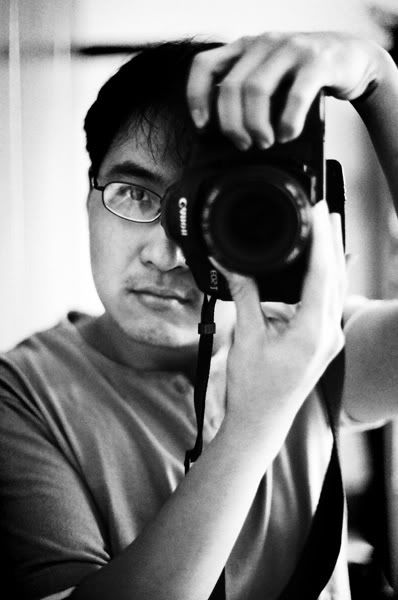For Techies
From my previous post "renew"
Thomas commented on the vibrant colours during the dinner.
"I was scrolling down and wondering how u managed to get such rich colours under banquet lightings...
So it was film~
Good stuffs!"
Only Image #9 and 12 were shot on film. Fuji Superia 1600 i think. The rest were digital.
Usually i would respond that correct white balance and exposures would give us the best colours. Alas, the dinner images were shot on AWB, the film images......what WB can i set on film**duh**
Thus i guess the correct exposure works. eg. Image #11 would have been overexposed if i had left it at aperture priority or program mode due to the dark surroundings. The colours from the light beams would have been white washed by a brightly exposed ambiance.
Image #13 was shot on auto totally.....AWB, Av mode. So why did it turn out ok? The camera.
Many on clubsnap argue that its the photographer who makes the image. I'd like to argue that both the photog and the equipment are equally important. Having moved from the Canon EOS 20D to 5D to 1Dmk3, the colours of my images have drastically changed whenever i changed cameras.
The 20D was a revolutionary camera when it was introduced abt 3-4 yrs ago with its "low noise" ISO1600 (bracketed cos its relative. These days i won't think of it as low noise) However the camera provides images with a certain orange hue to it which can take quite some time to correct during post processing. That was the period of time where alot of my portfolio images were in monochrome as the B&W film images just look way stronger than the colour digital files.
Then came the super saturated 5D colours with its even better noise control. I began showing more coloured images.
Now with the 1Dmk3. The colours are more toned down and it allows me to integrate seamlessly with colour film as they have almost the same look. Now who says equipment isn't important.
BTW. Nope. Shooting RAW only helps when you get it close enough. No software can rescue an image which does not have any blue channel data at all. Hence the control of white balance is so important especially in the digital era cos digital cameras tend to produce stronger coloured images and a wrong WB image would look ghastly. Film tends to provide a more moderate colour tone than digital but even so, the images can be overly warm if shot in dimly lit ballrooms. Hence the double edged sword of digital. It gives you the power to correct but do it wrongly and you will get a worse result.
Thomas commented on the vibrant colours during the dinner.
"I was scrolling down and wondering how u managed to get such rich colours under banquet lightings...
So it was film~
Good stuffs!"
Only Image #9 and 12 were shot on film. Fuji Superia 1600 i think. The rest were digital.
Usually i would respond that correct white balance and exposures would give us the best colours. Alas, the dinner images were shot on AWB, the film images......what WB can i set on film**duh**
Thus i guess the correct exposure works. eg. Image #11 would have been overexposed if i had left it at aperture priority or program mode due to the dark surroundings. The colours from the light beams would have been white washed by a brightly exposed ambiance.
Image #13 was shot on auto totally.....AWB, Av mode. So why did it turn out ok? The camera.
Many on clubsnap argue that its the photographer who makes the image. I'd like to argue that both the photog and the equipment are equally important. Having moved from the Canon EOS 20D to 5D to 1Dmk3, the colours of my images have drastically changed whenever i changed cameras.
The 20D was a revolutionary camera when it was introduced abt 3-4 yrs ago with its "low noise" ISO1600 (bracketed cos its relative. These days i won't think of it as low noise) However the camera provides images with a certain orange hue to it which can take quite some time to correct during post processing. That was the period of time where alot of my portfolio images were in monochrome as the B&W film images just look way stronger than the colour digital files.
Then came the super saturated 5D colours with its even better noise control. I began showing more coloured images.
Now with the 1Dmk3. The colours are more toned down and it allows me to integrate seamlessly with colour film as they have almost the same look. Now who says equipment isn't important.
BTW. Nope. Shooting RAW only helps when you get it close enough. No software can rescue an image which does not have any blue channel data at all. Hence the control of white balance is so important especially in the digital era cos digital cameras tend to produce stronger coloured images and a wrong WB image would look ghastly. Film tends to provide a more moderate colour tone than digital but even so, the images can be overly warm if shot in dimly lit ballrooms. Hence the double edged sword of digital. It gives you the power to correct but do it wrongly and you will get a worse result.
Labels: photography, ramblings


0 Comments:
Post a Comment
<< Home